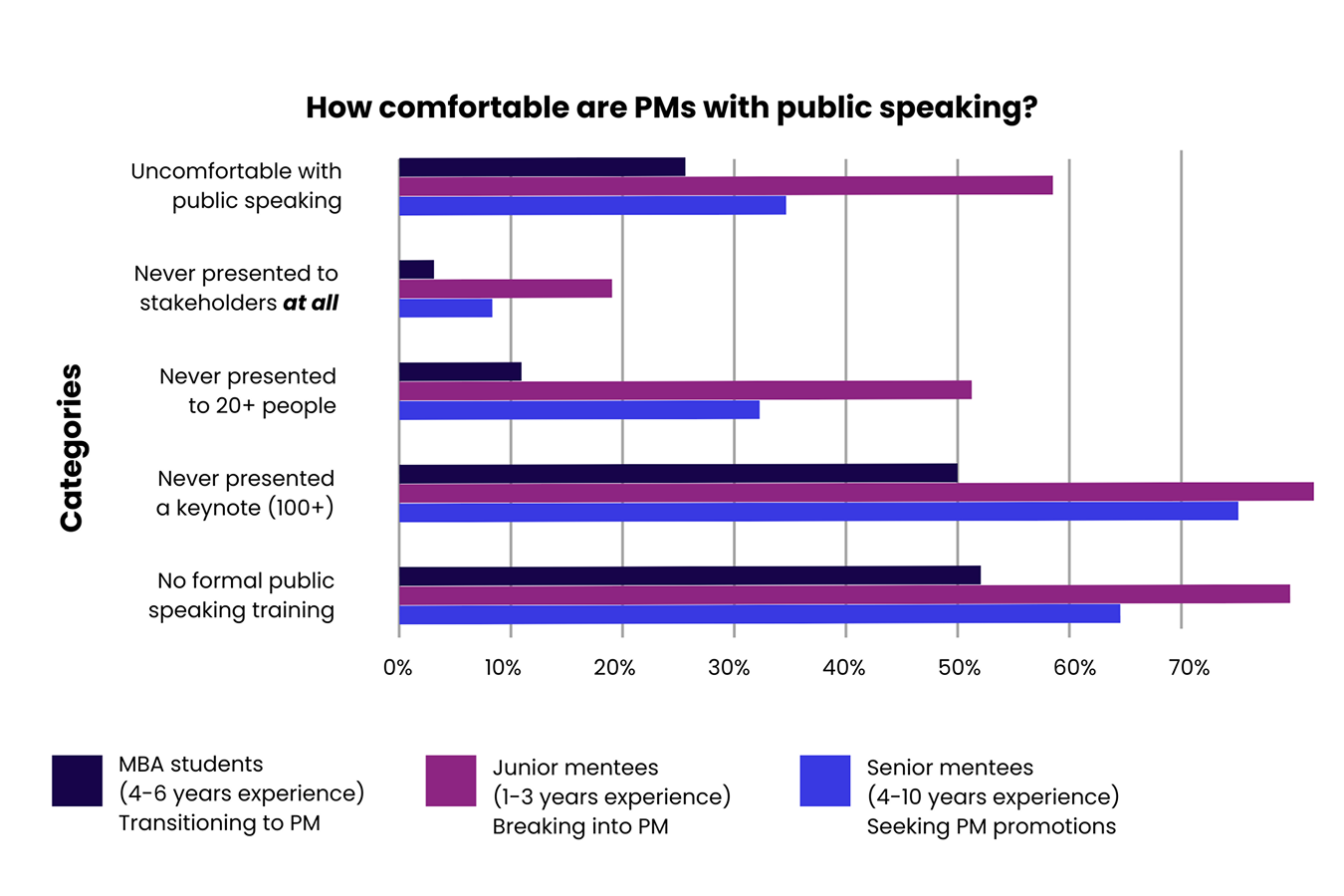During the last few months we’ve seen an uptick in interest in fractional product management and leadership from the product community.
We should start by being clear about what fractional product management is and isn’t. It’s not a full-time interim or short-term contract role, rather it’s applied to someone – experienced and senior – who comes into a business on a part-time basis (for a fraction of the time of a full-time hire) to offer their product expertise in a number of possible ways. They might work on product strategy, oversee product development, or work on organisation culture and strategy – essentially they’re providing high level product expertise and guidance for maybe two or three days a week or even only two or three hours a month. Many fractional product leaders also offer coaching and training, but these are separate from fractional leadership.
The appeal of fractional work
It’s easy to see the immediate appeal of fractional leadership for senior product people. In theory it takes them away from the day-to-day grind and politicking of corporate life, they have the opportunity to focus on the kind of work they excel at and most enjoy, they can choose when and where they work, and they can free up time for other interests. And for a business, particularly a startup or scaleup, it means it can avail itself of exceptional external experience and expertise that it wouldn’t otherwise be able to access, access that comes without the expense of a full-time senior hire.
But are there more opportunities for fractional product leaders than there used to be? It’s hard to judge. For all the noise over the past 12 months about the rise of fractional jobs, there’s a paucity of studies that look into whether the number of fractional product management opportunities are on the increase. The number of startups has grown hugely over the last few decades and a couple of articles point to US Bureau of Labor Statistics numbers which show an uptick in temporary business management roles, with an 18% increase from 2021 to 2022 and a 57% rise since 2020. What we can say is that consultants and market observers feel that fractional opportunities generally are growing because of the normalisation of hybrid and remote working, and because of the business need for the skills that fractional leaders can provide and the lower risk that taking on a fractional worker entails.
Is there an increase in demand?
Nick Charambolous, CEO of recruiters Few&Far, which focuses on product jobs in fast-growing digital businesses, says that the product people who do fractional work very well really understand the pain point that they solve, and productise their time. But he’s not seeing a noticeable increase in the demand for fractional product leaders. He believes that the companies that most need fractional CTOs or CPOs tend to be startups with funding or annual recurring revenue(ARR) and first-time founders, but they often don't understand that fractional product leadership is an option for them. “Their perception of an advisor is someone who is like a non-exec director,” Nick says, “someone who comes and takes a load of equity, and then doesn’t do much.” Could it be an untapped opportunity?
Nick has found that fractional product leadership works well (Few&Far places people in advisory as well as full-time roles) when a business has between £1 million to £5 million in ARR and the founders are thinking about hiring a CPO. In fact, the work would be better suited to a product lead, someone who can put a roadmap and product process in place but doesn’t have the high-level strategic thinking experience, commercial acumen, and understanding of how to build big teams, that you would expect from a CPO. Says Nick: “I always propose that rather than hire a CPO for £150,000 to £200,000, hire a product lead at, say, around £100,000, and bring in a fractional product leader – a proper CPO – to work with you one to two days a month.” This fractional leader can mentor the product lead and work with founders on product strategy, he says.
What about the work?
Which leads us to the work itself. How do fractional product leaders who are doing this work find it? And what qualities do they feel they need to succeed?
Caroline Clark has been a fractional product leader since June 2023. She also offers coaching and training with a particular focus on women in tech, because she would like to see an increase in the number of women working in tech industries. She took the step into fractional work because she was burnt out and had come to recognise that she needed more control over her time and where she put her attention “which you can't have fully in full-time employment”.
For Matt LeMay,a long-time consultant and fractional product leader, the flexibility of a fractional role has huge appeal. He plays music and occasionally goes on tour and fractional work gives him the space to do this. He also relishes the opportunity to focus on the highest impact and highest leverage activities that are at the crux of fractional leadership.
Holly Donohue moved into fractional work at the start of 2024, with her decision springing from a long-held ambition to run her own business. All three have different reasons for choosing to do fractional work, but they have similar stories to tell about the trials and tribulations for doing the work itself.
It’s still stressful
You’re running your own business, with all the ups and downs that go with it. You’re responsible for sales, pricing, marketing, management, financials, the whole lot. Not only do you have the work, you also have to find clients to work for. Conventional wisdom says you don’t need a network when you have a full-time job, but you certainly need one when you’re doing fractional work, and engage with it frequently because it’s where you’ll find your work. Fractional work means you have to keep marketing yourself and your services by going to meet-ups, grabbing speaking opportunities, writing blog posts and the like. As Holly says: “It’s the kind of role that is very network driven. People don't really advertise for a fractional CPO, so you've got to create that work for yourself.”
Says Caroline: “For example, my current contract came as a result of someone I previously worked with recommending me to his new company. You have to nurture your network, which perhaps you don't do so much when you're full-time.” Caroline devotes a lot of time to posting and having conversations on LinkedIn and getting out of the house to meet-ups and the like. She says: “It's about people knowing who I am, understanding my approach, and my philosophy around product leadership, product development, and then thinking, ‘yes, I want to work with Caroline’.” She says she always maintains a consistent level of marketing and then ramps it up for a couple of months prior to a contract end.
Holly has worked hard to build out her network, and says sometimes work will come from just one good conversation, sometimes from “40 conversations with lots of different people”, and at other times she’ll have to go through a procurement process and competitive pitching. She tries not to make it all about her and what she can offer when she pitches for work. ”I try to make it about them. If somebody wants me to come in and just pitch at them, they're probably not actually the kind of client I want to work with, I want somebody who |I can have an open conversation with,” she says.
As someone in her first year of fractional product management Holly is working on building up case studies, referrals and references, as well as her understanding of the needs of different groups of people. So far, she's found that speaking at leadership events has been the best way of generating leads.
You have much less security
There’s lots of security around a full-time role – you’re paid regularly, you have a holiday allowance, you have employment rights and benefits. As a fractional product person you have to accept there will be times when you’re less busy than you would like to be or have no work at all, and times when you might struggle with cash flow.
You may well have to enter into competitive pitches against other fractional product people for the work. Holly’s tactic here is to use a product management approach and think about what problems the business has, what problems it’s trying to solve and what it needs. “I find with scale-ups and enterprises, it tends to be more about solving a problem. Early-stage startups want a bit of help and advice to set themselves up in the right way.”
Recognise that you’re playing a long game. You may think that you can work for three days a week and play for the other two, but it will quite possibly take years of hard graft before you’re in that position.
There’s loads of variety
For example Holly says that she works with early startups with a bit of funding, offering help and guidance on product management, validating and testing ideas quickly and cheaply and trying to get product/market fit. She also works with scaleups who are growing quickly and need someone to help them understand the best ways of structuring their teams and their product work.
You engage with the business in a different way
It can be hard to gauge what authority you have, and you have to work through other people’s authority, rather than being able to rely on any authority you might have as a permanent employee.
As Matt points out, you’re not hiring or firing anyone and in some ways that can help with leverage – you can always say that you’re just “there to help and not a direct participant in the hierarchies and political dynamics with the organisation”. But it also can mean you have less leverage because people can just say, “That’s not applicable or helpful”. As Matt says: “There’s a different texture to the engagement.” He says you’re always asking about what’s really important and helping people to figure out where your time is best spent rather than inviting you to lots of meetings for form’s sake.
You need to be fearless about seeking out points of leverage
Matt says that one of the most challenging aspects of contract work is to be brought in with a particular remit, only to realise that the highest points of leverage are outside that remit. “It happens a lot,” he says. “You're brought in to help a team level up their discovery work and you realise the issue isn't in the way they conduct discovery, but in the way that they track progress against goals. Or you're brought in to help create role clarity, and you realise that the issue isn't role clarity, it's just getting people to do discovery work together.” Matt notes that it pays to be clear about this when you scope out projects with a company’s leadership team and regularly meet with them during the project so that everyone understands why you might land somewhere different from the project’s original scope.
It’s not for everyone
Balancing all the different activities you need to do as a one-man band product leader is tough. As Matt says: “Constantly having to hunt for new work is exhausting.” Holly adds that you have to make decisions all the time. “It’s hard and you get decision fatigue. There’s also lots of juggling, different prospects, different clients as well, and working out how you make all this work fit together.”
But it can be very rewarding
Caroline comments that as a fractional leader you bridge consultancy – which people engage with in the short term to tell them what they should be doing – and an internal employee who understands the context, but perhaps can't see that bigger picture. “I’m sitting in the middle,” she says. “'I’m a bit of a disrupter, helping the company out of its comfort zone to this new, uncertain, slightly ambiguous world that it’s never been in before. So the people that I work closest with within product, engineering, design and data, are super receptive to what I bring to the table. They want it, they need it – they're crying out for it.”







